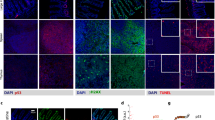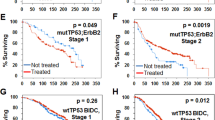Abstract
Exposure of murine and human tissues to ionizing radiation (IR) induces the expression of p16INK4a, a tumor suppressor gene and senescence/aging biomarker. Increased p16INK4a expression is often delayed several weeks post exposure to IR. In this context, it remains unclear if it occurs to suppress aberrant cellular growth of potentially transformed cells or is simply a result of IR-induced loss of tissue homeostasis. To address this question, we used a conditional p16INK4a null mouse model and determined the impact of p16INK4a inactivation long-term post exposure to IR. We found that, in vitro, bone marrow stromal cells exposed to IR enter DNA replication following p16INK4a inactivation. However, these cells did not resume growth; instead, they mostly underwent cell cycle arrest in G2. Similarly, delayed inactivation of p16INK4a in mice several weeks post exposure to IR resulted in increased BrdU incorporation and cancer incidence. In fact, we found that the onset of tumorigenesis was similar whether p16INK4a was inactivated before or after exposure to IR. Overall, our results suggest that IR-induced p16INK4a dependent growth arrest is reversible in mice and that sustained p16INK4a expression is necessary to protect against tumorigenesis.
This is a preview of subscription content, access via your institution
Access options
Subscribe to this journal
Receive 50 print issues and online access
$259.00 per year
only $5.18 per issue
Buy this article
- Purchase on Springer Link
- Instant access to full article PDF
Prices may be subject to local taxes which are calculated during checkout




Similar content being viewed by others
References
Le ON, Rodier F, Fontaine F, Coppe JP, Campisi J, DeGregori J et al. Ionizing radiation-induced long-term expression of senescence markers in mice is independent of p53 and immune status. Aging Cell 2010; 9: 398–409.
Wang Y, Schulte BA, LaRue AC, Ogawa M, Zhou D . Total body irradiation selectively induces murine hematopoietic stem cell senescence. Blood 2006; 107: 358–366.
Marcoux S, Le ON, Langlois-Pelletier C, Laverdiere C, Hatami A, Robaey P et al. Expression of the senescence marker p16INK4a in skin biopsies of acute lymphoblastic leukemia survivors: a pilot study. Radiat Oncol 2013; 8: 252.
Sanoff HK, Deal AM, Krishnamurthy J, Torrice C, Dillon P, Sorrentino J et al. Effect of cytotoxic chemotherapy on markers of molecular age in patients with breast cancer. J Natl Cancer Inst 2014; 106: dju057.
Salama R, Sadaie M, Hoare M, Narita M . Cellular senescence and its effector programs. Genes Dev 2014; 28: 99–114.
Burd CE, Sorrentino JA, Clark KS, Darr DB, Krishnamurthy J, Deal AM et al. Monitoring tumorigenesis and senescence in vivo with a p16(INK4a)-luciferase model. Cell 2013; 152: 340–351.
Sorrentino JA, Krishnamurthy J, Tilley S, Alb JG Jr., Burd CE, Sharpless NE . p16INK4a reporter mice reveal age-promoting effects of environmental toxicants. J Clin Invest 2014; 124: 169–173.
Yamakoshi K, Takahashi A, Hirota F, Nakayama R, Ishimaru N, Kubo Y et al. Real-time in vivo imaging of p16Ink4a reveals cross talk with p53. J Cell Biol 2009; 186: 393–407.
Serrano M, Lee H, Chin L, Cordon-Cardo C, Beach D, DePinho RA . Role of the INK4a locus in tumor suppression and cell mortality. Cell 1996; 85: 27–37.
Sharpless NE, Bardeesy N, Lee KH, Carrasco D, Castrillon DH, Aguirre AJ et al. Loss of p16Ink4a with retention of p19Arf predisposes mice to tumorigenesis. Nature 2001; 413: 86–91.
Sherr CJ, Roberts JM . CDK inhibitors: positive and negative regulators of G1-phase progression. Genes Dev 1999; 13: 1501–1512.
Zhou BB, Elledge SJ . The DNA damage response: putting checkpoints in perspective. Nature 2000; 408: 433–439.
Johmura Y, Shimada M, Misaki T, Naiki-Ito A, Miyoshi H, Motoyama N et al. Necessary and sufficient role for a mitosis skip in senescence induction. Mol Cell 2014; 55: 73–84.
Stein GH, Drullinger LF, Soulard A, Dulic V . Differential roles for cyclin-dependent kinase inhibitors p21 and p16 in the mechanisms of senescence and differentiation in human fibroblasts. Mol Cell Biol 1999; 19: 2109–2117.
Robles SJ, Adami GR . Agents that cause DNA double strand breaks lead to p16INK4a enrichment and the premature senescence of normal fibroblasts. Oncogene 1998; 16: 1113–1123.
Beausejour CM, Krtolica A, Galimi F, Narita M, Lowe SW, Yaswen P et al. Reversal of human cellular senescence: roles of the p53 and p16 pathways. Embo J 2003; 22: 4212–4222.
Ito K, Hirao A, Arai F, Matsuoka S, Takubo K, Hamaguchi I et al. Regulation of oxidative stress by ATM is required for self-renewal of haematopoietic stem cells. Nature 2004; 431: 997–1002.
Ito K, Hirao A, Arai F, Takubo K, Matsuoka S, Miyamoto K et al. Reactive oxygen species act through p38 MAPK to limit the lifespan of hematopoietic stem cells. Nat Med 2006; 12: 446–451.
Janzen V, Forkert R, Fleming HE, Saito Y, Waring MT, Dombkowski DM et al. Stem-cell ageing modified by the cyclin-dependent kinase inhibitor p16INK4a. Nature 2006; 443: 421–426.
Krishnamurthy J, Ramsey MR, Ligon KL, Torrice C, Koh A, Bonner-Weir S et al. p16INK4a induces an age-dependent decline in islet regenerative potential. Nature 2006; 443: 453–457.
Molofsky AV, Slutsky SG, Joseph NM, He S, Pardal R, Krishnamurthy J et al. Increasing p16INK4a expression decreases forebrain progenitors and neurogenesis during ageing. Nature 2006; 443: 448–452.
Sousa-Victor P, Gutarra S, Garcia-Prat L, Rodriguez-Ubreva J, Ortet L, Ruiz-Bonilla V et al. Geriatric muscle stem cells switch reversible quiescence into senescence. Nature 2014; 506: 316–321.
van Deursen JM . The role of senescent cells in ageing. Nature 2014; 509: 439–446.
Christophorou MA, Ringshausen I, Finch AJ, Swigart LB, Evan GI . The pathological response to DNA damage does not contribute to p53-mediated tumour suppression. Nature 2006; 443: 214–217.
Parrinello S, Samper E, Krtolica A, Goldstein J, Melov S, Campisi J . Oxygen sensitivity severely limits the replicative lifespan of murine fibroblasts. Nat Cell Biol 2003; 5: 741–747.
Ruzankina Y, Pinzon-Guzman C, Asare A, Ong T, Pontano L, Cotsarelis G et al. Deletion of the developmentally essential gene ATR in adult mice leads to age-related phenotypes and stem cell loss. Cell Stem Cell 2007; 1: 113–126.
Carbonneau CL, Despars G, Rojas-Sutterlin S, Fortin A, Le O, Hoang T et al. Ionizing radiation-induced expression of INK4a/ARF in murine bone marrow-derived stromal cell populations interferes with bone marrow homeostasis. Blood 2012; 119: 717–726.
Hinkal G, Parikh N, Donehower LA . Timed somatic deletion of p53 in mice reveals age-associated differences in tumor progression. PLoS One 2009; 4: e6654.
Dirac AM, Bernards R . Reversal of senescence in mouse fibroblasts through lentiviral suppression of p53. J Biol Chem 2003; 278: 11731–11734.
Coppe JP, Patil CK, Rodier F, Sun Y, Munoz DP, Goldstein J et al. Senescence-associated secretory phenotypes reveal cell-nonautonomous functions of oncogenic RAS and the p53 tumor suppressor. PLoS Biol 2008; 6: 2853–2868.
Krtolica A, Parrinello S, Lockett S, Desprez PY, Campisi J . Senescent fibroblasts promote epithelial cell growth and tumorigenesis: a link between cancer and aging. Proc Natl Acad Sci USA 2001; 98: 12072–12077.
Baker DJ, Wijshake T, Tchkonia T, LeBrasseur NK, Childs BG, van de Sluis B et al. Clearance of p16Ink4a-positive senescent cells delays ageing-associated disorders. Nature 2011; 479: 232–236.
Demaria M, Ohtani N, Youssef SA, Rodier F, Toussaint W, Mitchell JR et al. An essential role for senescent cells in optimal wound healing through secretion of PDGF-AA. Dev Cell 2014; 31: 722–733.
Acknowledgements
We are grateful to the members of Dr Elie Haddad’s laboratory, flow cytometry and animal facility for providing technical support. We also would like to thank Dr Francis Rodier and Mohamad El-Ariss for the critical reading of the manuscript. This work was supported by a grant from the Canadian Institute of Health Research #MOP-341566 to CMB LP has been supported by a student fellowship from the Fondation des Étoiles. CMB is supported by a scientist award from the Fonds de recherche du Québec - Santé.
Author information
Authors and Affiliations
Corresponding author
Ethics declarations
Competing interests
The authors declare no conflict of interest.
Additional information
Supplementary Information accompanies this paper on the Oncogene website
Supplementary information
Rights and permissions
About this article
Cite this article
Palacio, L., Krishnan, V., Le, N. et al. Sustained p16INK4a expression is required to prevent IR-induced tumorigenesis in mice. Oncogene 36, 1309–1314 (2017). https://doi.org/10.1038/onc.2016.298
Received:
Revised:
Accepted:
Published:
Issue Date:
DOI: https://doi.org/10.1038/onc.2016.298



